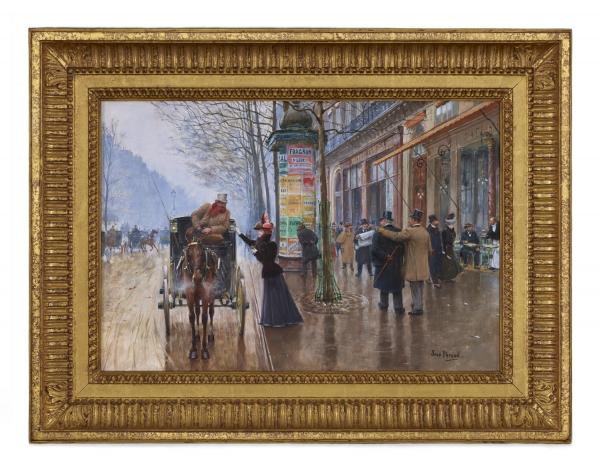Sold to an American collector just after it was painted in the concluding years of the 19th century, this lively depiction of a bustling Parisian boulevard epitomizes the glittering work of Jean Béraud. With characteristic lightheartedness and exquisite draughtsmanship, the painting features multiple vignettes of a seemingly typical day in the fashionable French capital in the late 1890s. In the foreground, a smiling woman in a fur coat has just alighted on the Boulevard des Capucines and pays her cab driver for her ride. The chilly weather is marked not just by her costume, but by the patient horse’s visible exhale. Men and women chat along the damp sidewalk, looking in windows and reading the day's news beneath a typically gray Parisian sky. From left to right, carriages give way to hats that establish the horizon in this precisely constructed composition, dividing the canvas between the muddy brown of street and sidewalk and the gray-blue haze of the winter afternoon sky. The rainbow that welcomingly breaks this dreary day is, notably, man-made, and appears at center: a Morris Column covered in dozens of brightly colored posters.
This ubiquitous form of street architecture served a dual purpose: as storage for sidewalk cleaners’ equipment and as a street-level bulletin board showcasing contemporary entertainment. Together these purposes reflect a city deliberately transformed from one in which political volatility was perceived to have emerged from the tangle of medieval streets into one in which wide sidewalks and grand boulevards nurtured a clean, consumer-friendly playground for the local and global bourgeoisie. At the far right, and likely to be our heroine’s destination, is the glint of the gold sign indicating the Café Américain, where a waiter is serving beer to a portly male customer. This café was a haunt for painters, artists, and intellectuals, among them Béraud himself, as well as his close friend, the writer Marcel Proust.
Béraud was also close to Edouard Manet and the Impressionist painters, and as a result, Béraud’s focus on representing the details, caricatures, and the most palatable aspects of modern life is infused with the lively brushwork of his more experimental compatriots. Because the city and its inhabitants were tastemakers at the time, A Parisian Street Scene is a natural nodal point that connects multiple celebrated collections of the museum. This includes not just painting and sculpture from France, but also photography, works on paper, costume, and decorative arts from fin-de-siècle Europe, America, and beyond that engage with fashion, advertising, popular entertainment, and graphic design.
During our 38th annual Collectors Committee Weekend (April 27–28, 2024), members of LACMA's Collectors Committee generously helped the museum acquire 10 works of art spanning a breadth of eras and cultures. Read more about all the acquisitions.



